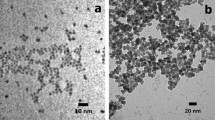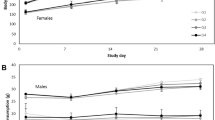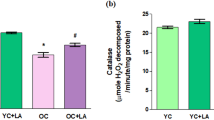Abstract
In the present investigation, we have studied the toxic potential of oleic acid anilide (OAA) and heated oleic acid anilide (HOAA) in relation to the toxic oil syndrome (TOS). Male Sprague-Dawley rats were given 250 mg/kg of OAA or HOAA in mineral oil by gavage, on alternate days for 2 weeks (total 7 doses). The control rats received an equal volume of mineral oil only. The animals were sacrificed at days 1, 7, and 28 following the last dose. Ratio of organ-to-body weight showed increases in spleen and kidney of HOAA and OAA treated rats, respectively, at day 1 while this ratio for liver in HOAA treated group showed a decrease at day 1. Among blood parameters, white blood cells increased in HOAA treated group at day 1 and in both OAA and HOAA groups at day 28. Mean corpuscular hemoglobin (MCH) and mean cell volume (MCV) also showed increases in the HOAA treated rats at days 7 and 28. Serum lactate dehydrogenase (LDH) decreased in both OAA and HOAA treated rats at day 1, while at day 7 the decrease was confined only to the HOAA group. Serum glutamic oxalacetic transaminase (GOT) and glutamic pyruvic transaminase (GPT) activities also decreased at most of the time points. Liver mitochondrial ATPase activity decreased in the HOAA group at day 7 and in the OAA group at day 28. Among serum immunoglobulins, IgA levels increased throughout the study but the changes were more pronounced in HOAA treated rats. Splenic T-lymphocyte number decreased in the HOAA treated rats at day 1, recovered at day 7, and then showed an increase at day 28. The B-cell population remained steady at all time points. The T-helper and T-suppressor cell numbers in both OAA and HOAA groups decreased at day 1. However, at days 7 and 28, T-helper cell numbers increased in HOAA group, whereas T-suppressor cells showed an increase in both OAA and HOAA treated rats at day 28. The changes observed as a result of exposure to OAA and HOAA and more so by HOAA, further support that fatty acid anilides may play a role in the pathogenesis of TOS.
Similar content being viewed by others
References
Altenkirch H, Stoltenburg-Didinger G, Koeppel C (1988) The neurotoxicological aspects of the toxic oil syndrome (TOS) in Spain. Toxicol 49:25–34
Blasco R, Sanz P, Fores I, Pastor T, Repetto M (1988) Effect of fatty acid anilides on the immune system of the swiss mouse: abnormalities in the synthesis of immunoglobulins. In: Meeting Abstract, V International Congress of Toxicology, July 16–21, Brighton, England, p 132
Castro Garcia M, Posada M, Diaz De Rojas F, Abaitua Borda I, Tabuenca Oliver JM (1986) Hypercoagulable states and the toxic oil syndrome. Ann Intern Med 104:730
Chinsky M, Shmagranoff GL, Sherry S (1959) Serum transaminase activity. J Lab Clin Med 47:108–118
Dianzani MU (1984) In: Calandra S, Carulli A, Salvioli A (eds) Lipid conjugation and haloalkylation: Two different mechanisms for CCl4-induced liver damage. Elsevier Science Publishers, BV, NY, pp 39–50
Dinman BD, Fox CF, Frajola WJ, Rabor A (1962) Serum enzyme and B12 changes in CCl4 hepatotoxicity. Arch Environ Health 4:168–182
Garcia Gil M, Traver J, Suarez C, Marin Cao D, Mato JM (1984) Evidence for generation of leukotriene B4 in human polymorphonuclear leukocytes treated with linoleylanilide. Biochem Pharmacol 33:3303–3306
Gavilanes FG, Municio AM (1983) Effect of oleoylanilide on the microviscosity of liver plasma membranes-Report of the Workshop on Toxic Oil Syndrome, Madrid, Spain
Gomez-Reino JJ (1987) Immune system disorders associated with adulterated cooking oil. In: Berlin A, Dean J, Draper MH, Smith EMB, Spreafico F (eds). Martinuo Nijhoff Publishers, Dordrecht, pp 376–389
Goulding D (1981) Toxic rape-seed oil. WHO-Report ICP/RCE 903 6819 B
Grandjean P, Tarkowski S (1984) Toxic oil syndrome. Mass food poisoning in Spain. In: Report of a WHO meeting, Madrid, March 21–25, 1983, p 3, World Health Organization Regional Office for Europe, Copenhagen
Gutierrez C, Gaspar L, Muro R, Kreisler M, Ferriz P (1983) Autoimmunity in patients with Spanish toxic oil syndrome. Lancet i:644
Hudson L, Hay FC (1976) Practical immunology, Blackwell Scientific Publications, Oxford, p 55
Kaphalia BS, Ansari GAS (1991) Rapid Chromatographic analysis of fatty acid anilides suspected of causing toxic oil syndrome. J Anal Toxicol 14:90–94
Khan MF, Kaphalia BS, Palafox A, Jerrells TR, Ansari GAS (1991) Heated linoleic acid anilide: Toxicity and relevance to toxic oil syndrome. Toxicol (in press)
Khan MF, Kaphalia BS, Ansari GAS (1991a) Heated linoleic acid anilide reduces serum enzyme activities in rats. Res Commun Chem Pathol Pharmacol 73:107–110
Kilbourne EM, Bernert JT, Jr, Posada, de la paz, M, Hill RH, Jr, Borda IA, Kilbourne BW, Zack MM, The Toxico-Epidemiologic Study Group (1988) Chemical correlates of pathogenicity of oils related to the toxic oil syndrome epidemic in Spain. Am J Epidemiol 127:1210–1227
Kilbourne EM, Rigau-Perez JG, Heath CW, Jr, Zack MM, Falk H, Martin-Marcos M, de Carlos A (1983) Clinical epidemiology of toxic oil syndrome. Manifestations of a new illness. N Engl J Med 309:1408–1414
Lahoz C, Tricas L, Vela C, Lauzurica P, Gurbindo C, Garcia R (1983) Hyper IgE, eosinophilia and immunological hyperreactivity due to ingestion of adulterated rapeseed oil (toxic oil syndrome). Eur J Respir Dis 64(suppl 126):415–418
Lowry OH, Rosebrough NJ, Farr AL, Randall RJ (1951) Protein measurement with the folin phenol reagent. J Biol Chem 193:265–275
Marquet A, Larraga V, Diez JL, Amela C, Rodrigo J, Munoz E, Pestana A (1984) Immunogenicity of fatty acid anilides in rabbits and the pathogenesis of the Spanish toxic oil syndrome. Experientia 40:977–980
Moss DW, Henderson AR, Kachmar KF (1986) The aminotransferases. In: Tietz NW (ed) Textbook of clinical chemistry, WB Saunders Co, Philadelphia, pp 669–678
Murphy R, Vodyanoy V (1982) Fatty acid anilides and the toxic oil syndrome. Lancet i:98
Nair RS, Auletta CS, Schroeder RE, Johannsen FR (1990) Chronic toxicity, oncogenic potential and reproductive toxicity ofp-nitroaniline in rats. Fundam Appl Toxicol 15:607–621
Pagani R, Portoles MT, Gavilanes FG, Gracia-Barreno P, Municio AM (1984) The mircoviscosity of liver plasma membranes of rat fed with oleoylanilide. Biochem J 218:125–129
Parker JC, Hoffman JF (1964) Failure to find increased Na+-K+ ATPase in red cell ghosts of schizophrenics. Nature 210:823–824
Pestana A, Munoz E (1982) Anilides and the Spanish toxic oil syndrome. Nature 298:608
Rabin RA, Bode DC, Molinoff PB (1986) Relationship between ethanol-induced alterations in fluorescence anisotropy and adenylate cyclase activity. Biochem Pharmacol 35:2331–2335
Rao GS, Kannan K, Goel SK, Pandya KP, Shanker R (1986) Subcutaneous kerosene toxicity in albino rats. Environ Res 35:516–530
Robbins SL (1976) Lymph nodes and spleen. In: Pathologic basis of diseae. WB Saunders Co, Philadelphia, p 769
Roncero AV, Valle CJD, Duran RM, Constante EG (1983) New aniline derivatives in coking oils associated with the cooking oil syndrome. Lancet ii:1024
Sanz P, Rodriguez-Vicente MC, Villar P, Repetto M (1986) Inhibition of glucose-6-phosphatase and adenosine-triphosphatase activity in rats treated with toxic Spanish rapeseed oil or synthetic anilides. Vet Human Toxicol 28:409–411
Sanz P, Villar P, Repetto M (1983) NADPH-diaphorase used to estimate enzymatic alterations in the toxic rapeseed oil syndrome. Vet Hum Toxicol 25:401–402
Sapru MK, Geetha H, Shetty KT (1987) A single reagent method of phosphate estimation in phosphatase(s) assay. Ind J Biochem Biophys 24:340–343
Silverman LM, Christenson RH, Grant GH (1986) Immunoglobulins. In: Tietz NW (ed) Textbook of clinical chemistry, WB Saunders Co., Philadelphia, pp 566–575
Tabuenca JM (1981) Toxic-allergic syndrome caused by ingestion of rapeseed oil denatured with aniline. Lancet ii:567–568
Ten RM, Kephart GM, Posada M, Abaitua I, Soldevilla L, Kilbourne EM, Dunnette SL, Gleich GJ (1990) Participation of eosinophils in the toxic oil syndrome. Clin Exp Immunol 82:313–317
Vicario JL, Serrano-Rios M, San Andres F, Arnaiz-Villena A (1982) HLA-DR3, DR4 increase in chronic stage of Spanish toxic oil disease. Lancet i:276
Wheals BB, Whitehouse MJ, Curry CJ (1982) Applications of liquid Chromatographic and spectroscopic methods for the characterization of fatty acid anilides in contaminated cooking oils. J Chromatogr 238:203–215
Wroblewski F, Ladue JS (1955) Lactic dehydrogenase activity in blood. Proc Soc Exp Biol Med 90:210–213
Author information
Authors and Affiliations
Rights and permissions
About this article
Cite this article
Khan, M.F., Kaphalia, B.S., Palafox, A. et al. Toxicity of oleic acid anilide in rats. Arch. Environ. Contam. Toxicol. 21, 571–577 (1991). https://doi.org/10.1007/BF01183880
Received:
Issue Date:
DOI: https://doi.org/10.1007/BF01183880




